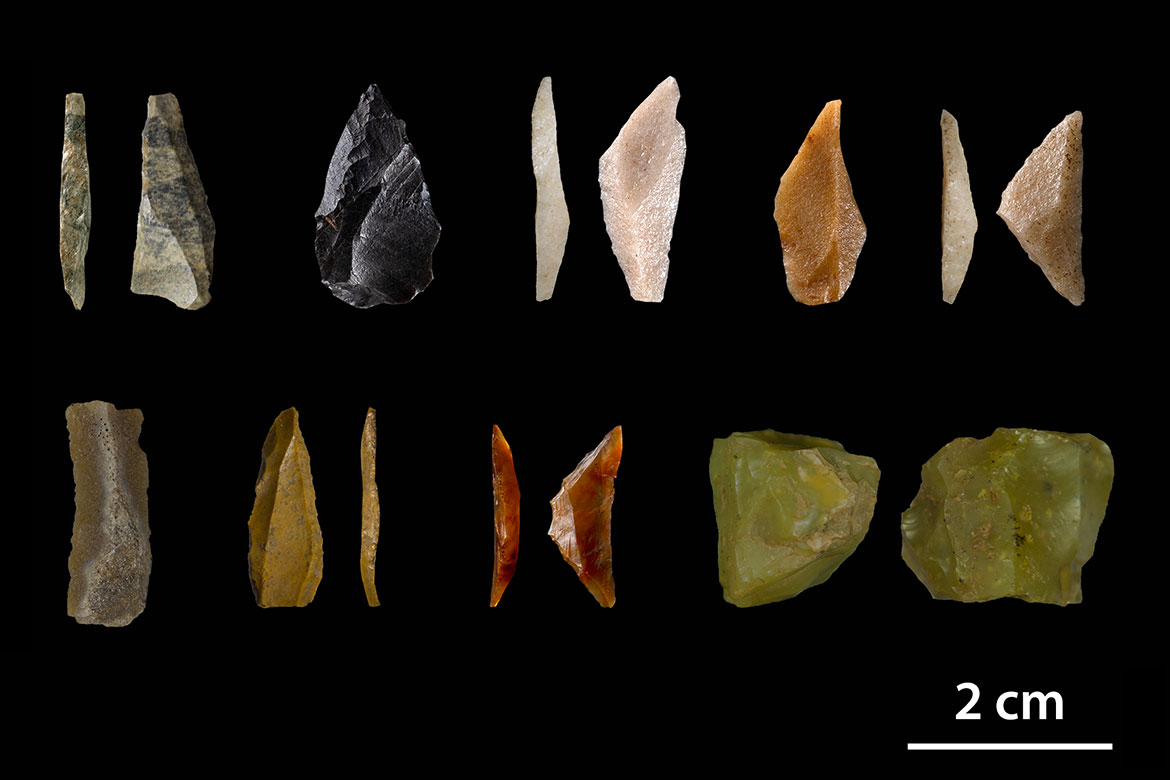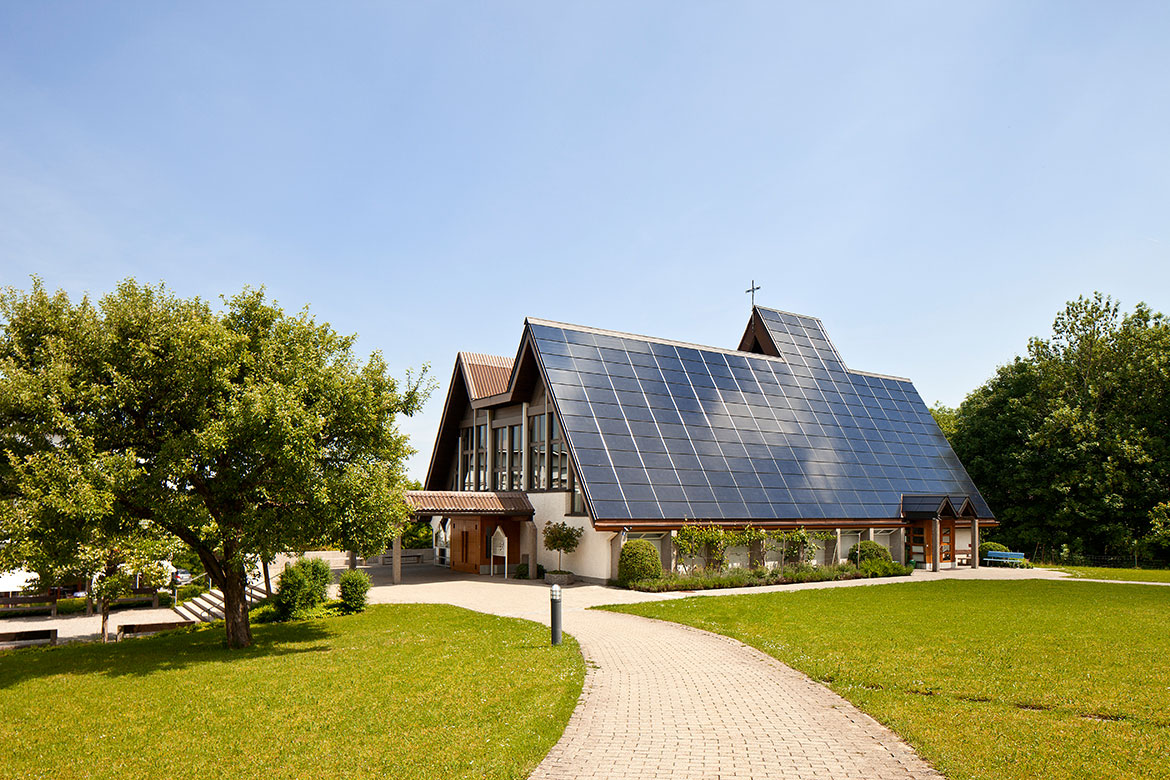Feature: Better cities
Away with the cars, bring us green spaces!
The smart city of the future is currently taking shape in Zurich West. To this end, researchers are making use of knowledge acquired in the garden city of Singapore. They’re planning ‘edible roofs’, heat-resistant trees and car-free spaces.
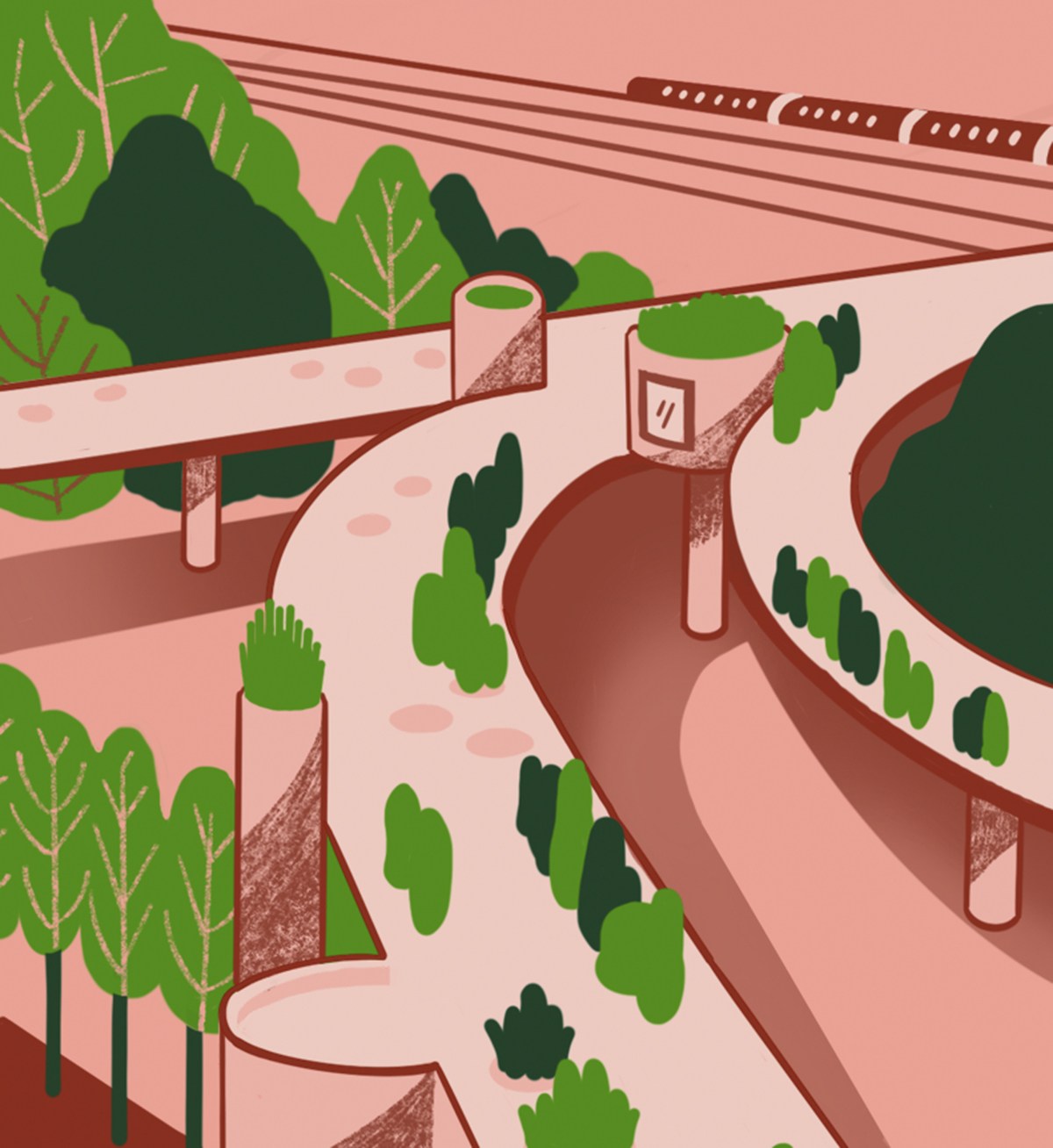
Ecological turn: A former motorway overpass in Seoul is now the ‘Skygarden’, a city park. | Illustration: Clara San Millán
It’s cold and grey in Zurich West this afternoon. Here, situated between the main Zurich railway station and the River Limmat, the old brick buildings and converted factories are reminders of the city’s industrial heritage – as are the names of its streets and squares, from ‘Schiffbau’ (‘shipbuilding’) to ‘Turbinenplatz’ (‘turbine square’). Since the 1990s, this area to the west of the Zurich city centre has been turned inside out, consolidated and made fit for the urban challenges of the future. When the Prime Tower was opened here in 2011, its height of 126 metres created a new benchmark for architecture in Switzerland, and it became a symbol of the city’s economic and urban growth. According to scenarios drafted by the City President’s Office, the population of Zurich will grow from its current 435,000 inhabitants to 514,000 by 2040.
From Shenzen via Hongkong and Singapore to Zurich
The urban researcher Michelle Yingying Jiang is waiting for me in front of a modern hotel that stands amidst cafés and fitness centres. She grew up in China, studied architecture in Shenzhen and Hong Kong, worked for several years in Singapore, and is currently the coordinator of the research project ‘Dense and Green Cities’ at the Zurich hub of the Future Cities Lab (FCL) of ETH Zurich. The FCL was founded in 2010 and comprises teams based in both Zurich and Singapore. The latter, a city state situated on an island at the southernmost tip of Malaysia, is considered by many urban researchers to be an ideal model of a highly dense, green, smart city.
Since 2012, researchers from Jiang’s team have been analysing Singapore’s development. They evaluate satellite images and take surveys of the residents to find out how they use the urban infrastructure and whether or not they are satisfied with their living situation. Their research findings are also intended to benefit urban development here in Switzerland. To this end, the research team entered into a collaboration with the city of Zurich in early 2021. Ten urban researchers each in Zurich and Singapore are spending the next five years analysing the status of urban planning in each city, along with the respective architectural, ecological, social, political and economic environment of ‘densely built, green cities’.
Zurich West is one of the field research sites for Jiang’s team. As we walk through it, she talks about her findings in Singapore and what will make the successful cities of the future. We walk through a residential area towards the River Limmat. She stops abruptly in front of a small garden where there are young trees, mint bushes and sage. There is a bakery-cum-café next door, where climbing plants are growing up the façade. Here, surrounded by tall, multi-storey office buildings, this small patch of garden looks like a green oasis, even in winter. Jiang says: “I’m sure many people come to sit outside here in the summer”.
The FCL researchers are convinced that green spots like this are going to become even more important in the smart cities of the future. They promote health and create habitats for small animals, birds and insects, thereby increasing biodiversity – which in itself is also relevant to increasing the production of food in urban areas. There will be honey from high-rise roofs, and lettuces and tomatoes grown in urban gardening projects.
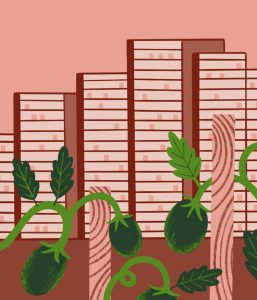
1. Thirteen raised beds for urban vegetables: a rooftop terrace in Lochergut in Zurich | Illustration: Clara San Millán
The Zurich association ‘Edible Roofs’ is currently trying to motivate people to grow vegetables on any unused terraces and flat roofs. In April, an initial terrace was planted on the Lochergut site in the former working-class district of Zurich-Aussersihl. It comprises 13 raised beds with 4,600 litres of soil (portrayed in image 1).
Green spaces like this are also meeting places that promote social interaction in neighbourhoods. Besides the official parks, small patches of green like the garden by the bakery in Zurich West constitute a large proportion of the world’s urban green spaces. In a study of nine Chinese megacities (i.e., urban areas with populations of over ten million people), researchers recently concluded that most green spaces comprise small, fragmented patches of less than 0.1 hectares each. Urban planners had long overlooked such small green areas, though they provide important services to a city’s ecosystem. For some years now, a so-called ecological turn has been taking place in architecture and urban planning.
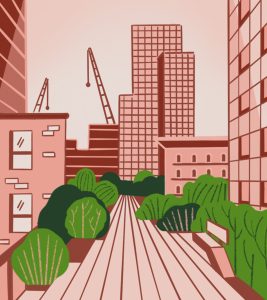
2. A promenade for people where there was once a goods train line: High Line Park, New York | Illustration: Clara San Millán
In New York and Paris, old metro lines are being transformed into green pedestrian boulevards (image 2). In 2017 in Seoul, a disused motorway overpass one kilometre long and 16 metres off the ground was converted into the ‘Skygarden’, a public park with 24,000 plants and 50 tree species (see the image at the top of this article).
Milan has been home to a ‘vertical forest’ (the ‘Bosco Verticale’) since 2014 (image 3). Here, the balconies and terraces of two towers, 80 and 104 metres high respectively, were planted with 900 specially grown trees and 2,000 other plants. They absorb CO2, purify the air, and are intended to function as ‘stepping-stone’ biotopes that will make it easier for animals to migrate between the city’s parks, avenues and wastelands. This vertical forest has played a significant role in the overall renewal of the former working-class district of Porta Nuova, though there have also been accusations of ‘eco-gentrification’ and criticism of rising rents.
Singapore in many ways embodies the ideals of a green, densely built city. In 1967, the then Prime Minister Lee Kuan Yew gave his rapidly growing metropolis the name of ‘Garden City’. In 1998, this was changed to ‘A City in a Garden’. Since then, the Singapore government has encouraged building developers from both the state and private sectors to integrate green spaces in their urban designs. The results are spectacular green façades and tropical gardens on spacious terraces at dizzying heights. The ‘Green Heart’ building complex in the Marina Bay financial district is an impressive example of these developments: it features a publicly accessible park with 350 tropical plants and trees across several floors, all situated between four skyscrapers (image 4).
Urban heat nightmares
According to the UN, some 70 percent of the world’s population will be living in cities by the year 2050; currently, that figure is 55 percent. This degree of growth, coupled with increasing heatwaves, extreme weather events and air pollution is going to pose enormous challenges for architects and urban planners. Coastal cities will also have to cope with rising sea levels. Christophe Girot is a landscape architect and a professor at ETH Zurich, and he puts it this way: “In the 21st century, urban planning is increasingly going to mean landscape planning”. For a long time, green spaces used to have a decorative purpose in urban planning, but they are more often taking on a core function today, given that our climate and biodiversity are entering a state of crisis.
Green spaces can help to regulate the microclimate, for example. Especially in metropolises along the tropical rain belt such as Jakarta, Manila, Bangkok and Singapore, urban heat is becoming more and more of a health and energy nightmare. Temperatures in the downtown, high-density areas of Singapore can at times be up to seven degrees Celsius higher than in less densely built-up areas where there are lots of green spaces. This is due to sealed tarred roads and concrete façades that store the heat from the sun’s rays. Then there are cars, industry and power plants that all consume fossil fuels. Singapore tries to combat these problems by using thousands of air conditioners. Today, it has the highest density of air conditioners in all Southeast Asia. But they consume vast amounts of electricity, and the waste heat they dispose of simply makes the urban heat island even worse. It’s a vicious circle.
Artificial mist
Researchers at FCL are currently working with a data model of the city – a ‘digital urban climate twin’ that can enable city planners to test various possible interventions in a virtual world. The model is provided with data on buildings, traffic, vegetation, surfaces, wind, solar radiation and the movement habits of the population. The planners can then simulate the impact on the local climate if building ensembles are positioned differently, or if dark surfaces – e.g., asphalt roads and building façades – are replaced with lighter surfaces that reflect more solar radiation.
The ‘urban heat island’ effect is also becoming a bigger problem in Zurich. According to calculations by the real estate consultants Wüest Partner, even a moderate climate-change scenario means that the annual number of days in the city over 30 degrees Celsius will increase by 19 by the year 2060, compared to the norms of 1981 to 2010. This will have a negative impact on the general well-being of the population: on their sleep quality, their productivity at work, and their state of health. Green infrastructure would be an effective countermeasure – trees most of all. Jonas Schwaab is a geo-ecologist at ETH Zurich. He has used satellite data on 293 European cities to evaluate the influence of vegetation on urban temperatures and has concluded that the surface temperature (nb. not the air temperature) of cities in Central Europe could be reduced by 8–12 degrees Celsius by planting additional trees.
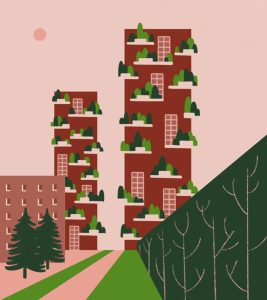
3. A garden that grows up to the sky: Bosco Verticale, Milan | Illustration: Clara San Millán
Zurich has meanwhile declared war on the urban heat island. At the Koch-Areal, a site between the suburbs of Altstetten and Sihlfeld, a total of 325 not-for-profit apartments for 900 people are due to be completed by 2025, along with a commercial building and a neighbourhood park 12,000 square metres in size. In the tender issued by the city for this urban development project, it was stipulated for the first-ever time that project proposals had to make a positive contribution to the urban climate. In the winning bid, the individual buildings are situated so that air can circulate well and cool the space by natural means. The city presented a basic plan for its urban climate in spring 2020 and followed this up by adopting a new action plan for heat mitigation in March 2021. Taking climate analysis conducted by the canton as its starting point, it lists measures for reducing the heat load in outdoor spaces. One unusual innovation will be tested for the first time in summer 2022 at Turbinenplatz in Zurich West: artificial mist. Water will be sprayed through fine nozzles in a large ring suspended six metres above the ground, thereby cooling the environment. And since December 2021, the city has been supporting green façades and roof greening projects on private property with up to CHF 30,000 each.
Footpaths, not roads
This increased focus on the greening of inner cities is also in line with another trend in urban planning: the 10-minute or 15-minute city. This concept is the brainchild of Carlos Moreno, a professor of complex systems at the Sorbonne University and special envoy for smart cities to the Mayor of Paris. His idea is that all the important functions of daily life – from shopping to healthcare, education, social contacts, work and recreation – should be reachable within 15 minutes by foot or in five minutes by bike.
Moreno has become the figurehead of a movement campaigning to upend the fact that cities since the early 20th century have been planned primarily to meet the needs of car drivers. Today, some 1.3 billion cars are in use across the world, with 300 million of them in Europe alone. According to the OECD, transport infrastructure – roads in particular – took up 25–40 percent of public space in cities in 2006. Moreno wants to make cities accessible once again for walking, cycling and local community activities, and he is convinced that this will create better-connected neighbourhoods with a higher quality of life. What’s more, it will reduce individual leisure traffic, energy consumption, and greenhouse gas emissions.
Singapore is trying out the 10-minute rule and is also localising food production at the same time. According to a 2020 survey of 1,500 citizens of Singapore (both men and women), 94 percent of them would like locally produced food. Currently, however, 90 percent of foodstuffs are imported into the city state. “Urban farming has become a hot topic in Singapore”, says Jiang. According to the ‘Singapore Green Plan 2030’, the island wants to produce 30 per cent of its own food by 2030. To this end, experiments are currently being conducted with rooftop vegetable fields and vertical farms in high-rise buildings.

4. An airy tropical paradise: the Green Heart Complex in Singapore
Preserving history
In Zurich West, Jiang can already see many characteristics of a 15-minute city in place today. People whizz by in bicycle lanes, and the surrounding neighbourhoods are easily accessible on foot. Jiang believes that this area’s mix of living, working, learning, eating and shopping is truly balanced. “It also means that you don’t get ‘dead’ neighbourhoods after working hours, as is the case in many big cities”, she says. In November 2021, the city electorate voted in favour of the structural plan proposed by the authorities. One of its aims is to shorten distances even further in the future and to link the centres of 49 neighbourhoods even better by means of attractively designed connections. For Jiang, the successful city of the future will be notable for one more feature: flexibility. “The pandemic has once again heightened our awareness of this”, she says. “From one day to the next, thousands of people were working from home. Entire office towers were suddenly empty. We need multifunctional buildings and cities that can adapt to a process of continuous change”.
The last stop on our tour of the former industrial estate is the railway viaduct near Hardbrücke. It was built in 1894, and its high arches once provided stonecutters with shelter for their work. The viaduct has since undergone a repurposing project, and its arches are now home to a covered food market, event spaces, restaurants and a number of clothing and furniture shops. Jiang sees this as an example of the limits to comparisons with Singapore. “European cities can look back on several centuries of history, so it is essential to treat existing buildings with care”. This is very different from Singapore – or many places in China where cities have only sprung up in the last few decades and were more or less planned on the drawing board. “Converting existing infrastructure like this viaduct can make cities interesting and sustainable”, says Jiang. “It says something about the history and culture of this neighbourhood and the city. It helps to create identity”.

